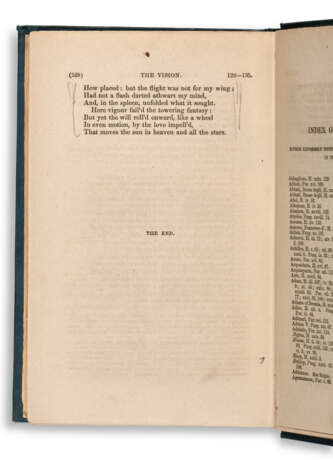ID 797316
Lot 677 | Dante's Divine Comedy
Estimate value
$ 100 000 – 150 000
Herman Melville’s heavily annotated copy of Dante’s Divine Comedy, with his ownership signature on the front free endpaper.
Approximately 175 pages include penciled annotations—check marks, underlining, etc.—with 25 of these pages including one or more words, for a total of approximately 133 words. This count does not include lengthy notes to the rear free endpaper that have been erased but are still somewhat visible. Signed on the front endpaper “Herman Melville,” and dated in two places: on page one, “A.D. 1858,” and on p. xlviii, “Pacific Ocean Sunday Afternoon Sep. 22, 1860.” On the contents page he has also marked "C.H.2," which has been identified by Melville's Marginalia as referring to his second time around Cape Horn in 1860 while aboard his brother Thomas's ship, the Meteor (his first would have been in 1841 while on the Acushnet).
Herman Melville purchased this book from John Wiley's on 22 June 1848 for $2.12 (Sealts). Melville's works after 1848 which make regular reference to Dante include Mardi, White Jacket, Moby-Dick, Pierre, Clarel, and Billy Budd. Of these, Moby-Dick is the most clearly parallel, with the first-person narrator making an unlikely journey through and survival of hell. However, Reese notes in particular that "Dante was a major influence on the structure of Mardi. Melville returned to reading Dante on numerous occasions, and seems to have taken this book with him on his voyage to San Francisco in 1860." Indeed, in the autumn of 1859,40-year old Melville was "sick and demoralized," not least from giving lectures that paled in comparison to the giants of the day, including the likes of Ralph Waldo Emerson and Henry Ward Beecher. He had little enthusiasm for the lecture circuit and was already considering applying for a post at the New York Customs House (it would eventually happen toward the end of the decade). When Thomas Melville came home the following April, he invited his dispirited brother to keep him company on his upcoming voyage from San Francisco to Shanghai. Herman eagerly agreed; he would be gone an entire year. In preparation he packed a small library that included Homer, Dante, Milton, Wordsworth, and Schiller. So it was on this journey across the Pacific Ocean aboard the Meteor that the author revisited his well-thumbed copy of the Divine Comedy, inscribing it once more on a Sunday afternoon in September. The trip was not as relaxing as "the middle-aged mariner" hoped and Melville found himself homesick for Arrowhead and his children (Robertson-Laurent, chapter 21).
One of Melville's most substantive notes includes a transcription of and comment on a remark by Walter Savage Landor on Dante: "'What execrations! What hatred against the human race! What exultation and merriment at eternal sufferings!—In this view, the 'Inferno' is the most immoral and impious book ever written.' Thus savagely writes Savage Landor of the still more savage Tuscan." (The two last lines of the inscription have been erased.) Landor's review of Cary's Dante does not seem too different from some of the contemporary reviews of Moby-Dick.
Other notes consisting of two or three words include glosses to various details within the world of the Divine Comedy. Otherwise numerous lines and passages throughout have been bracketed in the margin, underlined, or given a check mark. Scholars have noted that this volume “presents substantial challenges for editing and study,” as it “passed through the hands of subsequent owners and contains marginalia by at least one additional reader […] Marginalia not in Melville's hand are most clearly present in the section devoted to Dante's 'Paradise,' where all of the marginal annotations and likely also the pencil illustrations accompanying them were inscribed by one or more later readers” (Melville’s Marginalia, “Documentary Note on Melville's Marginalia in Dante's The Vision”). Sealts 174.
Octavo. Engraved portrait frontispiece. Publisher’s blue cloth, spine decorated in gilt (a little rubbing, spine lightly toned, f.f.e., frontispiece, and a gathering in the preliminaries are detached; chip to rear endpaper). Custom quarter morocco clamshell box. Provenance: Herman Melville, 1819-1891 – The Edward and Betty Marcus Foundation (Christie’s New York, 22 November 1985, lot 84) – Haven O’More (bookplate, his sale, Sotheby’s 9-10 November 1989, lot 181).
Exhibited: "A Herman Melville Collection ... on the occasion of the 100th anniversary of his death, from the collection of William S. Reese," Beinecke Rare Book and Manuscript Library, Yale University, 1991, no. 8.
| Place of origin: | USA |
|---|---|
| Auction house category: | Printed books |
| Place of origin: | USA |
|---|---|
| Auction house category: | Printed books |
| Address of auction |
CHRISTIE'S 20 Rockefeller Plaza 10020 New York USA | ||||||||||||||
|---|---|---|---|---|---|---|---|---|---|---|---|---|---|---|---|
| Preview |
| ||||||||||||||
| Phone | +1 212 636 2000 | ||||||||||||||
| Fax | +1 212 636 4930 | ||||||||||||||
| Conditions of purchase | Conditions of purchase | ||||||||||||||
| Shipping |
Postal service Courier service pickup by yourself | ||||||||||||||
| Payment methods |
Wire Transfer | ||||||||||||||
| Business hours | Business hours
|







